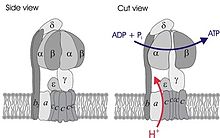Ephraim Racker
Efraim Racker , also Ephraim Racker, (born June 28, 1913 in Neu Sandez , † September 9, 1991 ) was an American biochemist.
Life
Racker was born in Galicia , in the former Austria-Hungary. He came from a Jewish family and grew up in Vienna. His brother Heinrich Racker became a well-known psychoanalyst . In 1932 he applied to the Academy of Fine Arts Vienna and was accepted. However, he dropped out of art studies to study medicine, inclining towards psychiatry. In March 1938, after the annexation of Austria by the National Socialists, Jews were initially banned from the universities, and in July of the same year he was allowed to complete his studies. He then fled to England, where he worked for a short time in a mental hospital in Cardiff and tried to find the biochemical causes of neuronal diseases with the biochemist J. Hirsh Quastel. From there he emigrated to the USA in 1941. There he researched the biochemistry of neuronal diseases at the University of Minnesota in 1941/42 , where he discovered that the polio virus inhibited glycolysis in the brain of mice. He then worked as a doctor at Harlem Hospital in New York City and in 1944 became Associate Professor of Microbiology at New York University Medical School. In 1952 he went to Yale University and in 1954 to the Public Health Research Institute of the City of New York City.
Here he made his fundamental discoveries about the role of ATP in the transfer of energy in cells, whose role as the main supplier of energy in the cell had already been shown by Fritz Lipmann in 1941. Racker showed that glycolysis was dependent on the presence of ATPase and the constant supply of ADP and phosphate groups from which ATP is built. Together with Maynard E. Pullam, Anima Datta and Harvey S. Penefsky, they identified the enzymes involved in the synthesis of ATP in the mitochondria . They isolated the first enzyme (F1 part of ATP synthase ) in 1960.
In 1966 Racker founded the Biochemistry Department at Cornell University , where he became Albert Einstein Professor of Biochemistry and Molecular Biology . He published over 500 scientific papers, numerous essays and 6 books. In addition to his scientific activities, he was an ambitious painter throughout his life. From 1945 until his death he was married to Franzi Weiss, with whom he had a daughter.
Honors
- 1962: Admission to the American Academy of Arts and Sciences
- 1966: Admission to the National Academy of Sciences
- 1974: Warren Triennal Prize
- 1976: National Medal of Science
- 1979: Harvey Prize
- 1980: Gairdner Foundation International Award
Fonts
- A New Look at Mechanisms of Bioenergetics , Academic Press, 1976
- as editor Energy transducing mechanisms , London, Butterworths 1975
Web links
- Biography of Gottfried Schatz in the Biographical Memoirs of the National Academy of Sciences 1996
- Biography on Cornell University website
- E. Racker picture collection on Cornell University website
| personal data | |
|---|---|
| SURNAME | Rascal, Ephraim |
| ALTERNATIVE NAMES | Rascal, Ephraim |
| BRIEF DESCRIPTION | American biochemist |
| DATE OF BIRTH | June 28, 1913 |
| PLACE OF BIRTH | New Sandez |
| DATE OF DEATH | September 9, 1991 |
